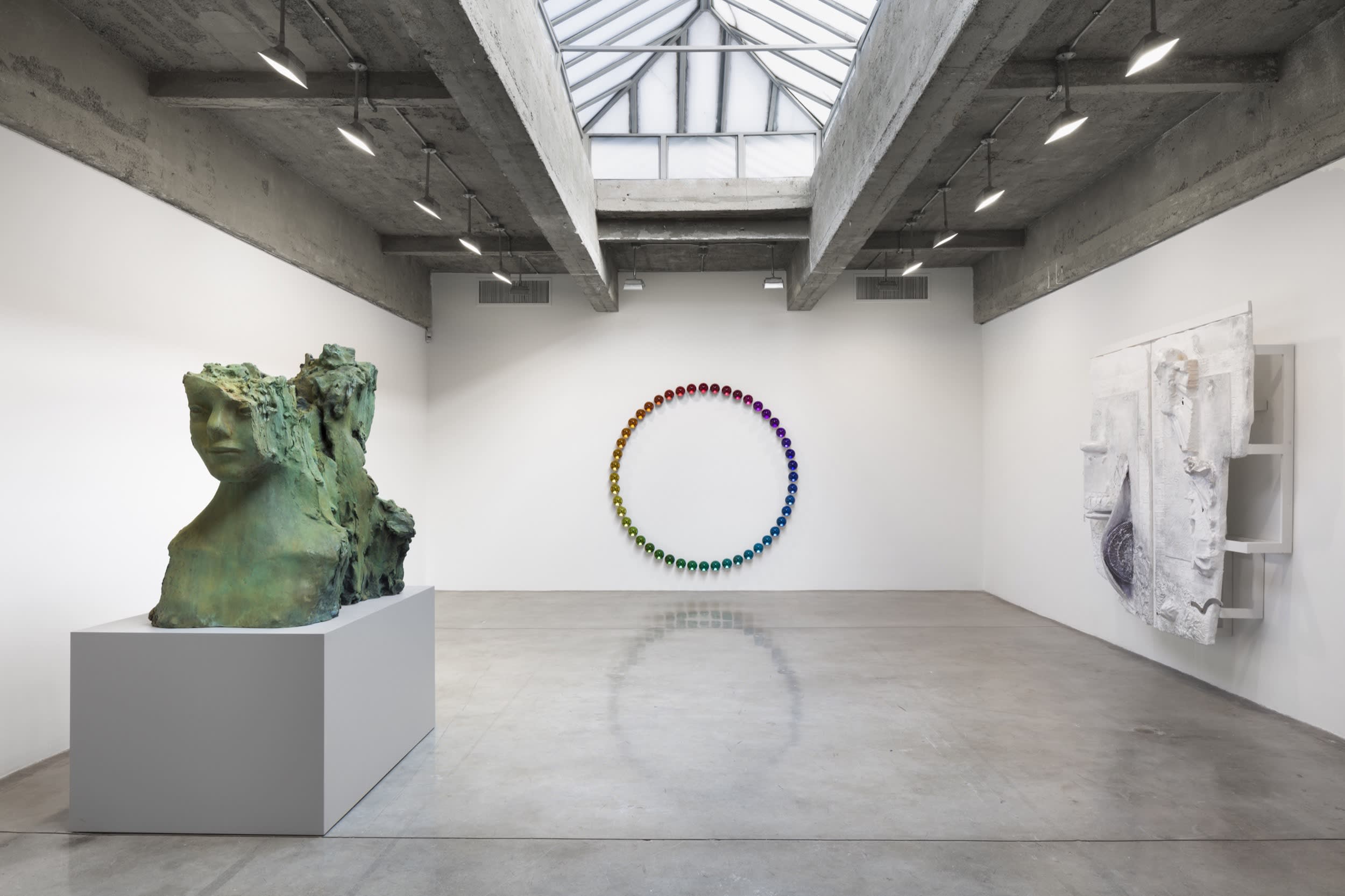
Tanya Bonakdar Gallery is pleased to present IRL, a second chapter in its ongoing series of IRL exhibitions featuring important new work by gallery artists. An acronym for “In Real Life”, the term IRL has taken on profound new resonance in the context of contemporary culture overall, and the visual arts specifically. The primary nature of the in-person, "real life", experience of visual art has become an existential issue for artists, galleries and museums, in a climate where the virtual, digital or otherwise mediated experience necessarily predominates. The works on view have been carefully selected to emphasize textures, materials, forms, colors and phenomena for which representation as images on screens falls (quite literally) flat.
IRL features work by Kelly Akashi, Sandra Cinto, Olafur Eliasson, Charles Long, Mark Manders, Karyn Olivier, Lisa Oppenheim, Susan Philipsz, Analia Saban, Tomás Saraceno, Sarah Sze and Lisa Williamson.

Through the precise arrangement of objects, many of which form the backdrop of our daily existence but are overlooked-- toothpicks, lamps, rubber bands, masking tape and more — Sze creates structures that explore how we see, understand, and order our universe. Sze’s compositions focus on our perception of scale, creating unexpected shifts as the eye zooms into sections of the work, and retreats out again to comprehend the structures as a whole. On both micro and macrocosmic levels Sze's sculptural model is transfixing and as you spend more time deciphering the parts that make up the whole, references to natural history, art history, mathematics, and physics emerge. In this way, Landing (Nest Series) becomes a kind of proposal for how these subjects inscribe order on a chaotic world.

Sarah SZE
Landing (Nest Series)
2011
mixed media (archival paper, silkscreen, lamp, branches, and enamel)
24 x 18 x 17 inches; 61 x 45.7 x 43.2 cm

Saraceno has long included arachnology as a tool for the investigation of alternative constructions. For Saraceno, spider webs spark inquiry into possible modes of redefining relationships between humans and nature, proposing utopian conditions for sustainable societies. Formed of suspended complex interwoven geometries, each piece appears as a unique galaxy floating within an expansive landscape. The work’s title reveals the technical basis for each sculptural element; such as the genus and species of the spider collaborators and the amount of time spent constructing their webs.

Tomás Saraceno
Hybrid Dark semi-social Cluster HIP 21594 built by: a duet of Cyrtophora citricola - three weeks, rotated 90°
2019
Spidersilk, carbon fiber, glass, metal
17 1/8 x 9 1/2 x 9 1/2 inches; 43.6 x 24.1 x 24.1 cm

Since the early 1990s, Sandra Cinto has developed a rich vocabulary of symbols and lines to create lyrical landscapes and narratives that hover between fantasy and reality. Using drawing as her point of departure, the artist renders intricate and mesmerizing seascapes, rainstorms, and celestial skies that frequently engage with the surrounding architecture to create seemingly weightless, immersive environments. Evoking stories of human hardship and redemption, Cinto's fantastical imagery serves as a metaphor for the human odyssey, while also pushing the limits and possibilities of drawing.
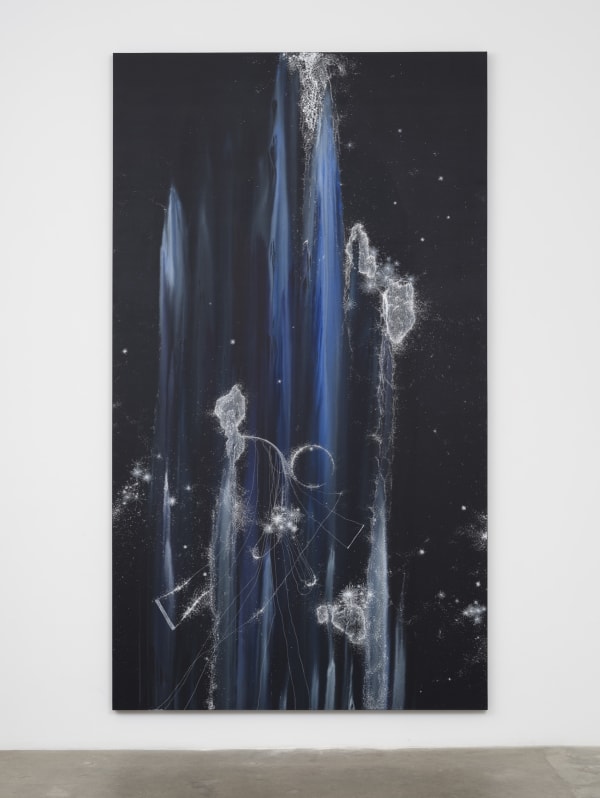
Sandra CINTO
Untitled (From the series Cosmic Garden/Nocturnal)
2021
Permanent pen and acrylic on canvas
133 7/8 x 76 1/8 inches; 340 x 193.5 cm

Remarkable in scale and execution, this work was produced through an intimate logic that has now become signature to Manders' practice. Rendered entirely in cast bronze, two figures joined, but facing away from one another appears to be soft clay mid-way through the process of becoming a sculpture. In casting the sculpture in bronze, the artist freezes a very specific moment in time, highlighting the fragility of every moment that passes. The manipulation of material and scale generates a sense of puzzlement and awe, masterfully creating a sense of timelessness— while the sculpture seems to be just made, it is at the same time enigmatically atemporal. Two Immovable Heads is related to Manders’ monumental site-specific permanent installation at the Rokin Art Foundation in Amsterdam.

Mark MANDERS
Two Immovable Heads
2015-16
Patinated bronze
54 3/8 x 63 1/2 x 41 1/8 inches; 138 x 161.5 x 104.4 cm
Edition of 3, 1 AP
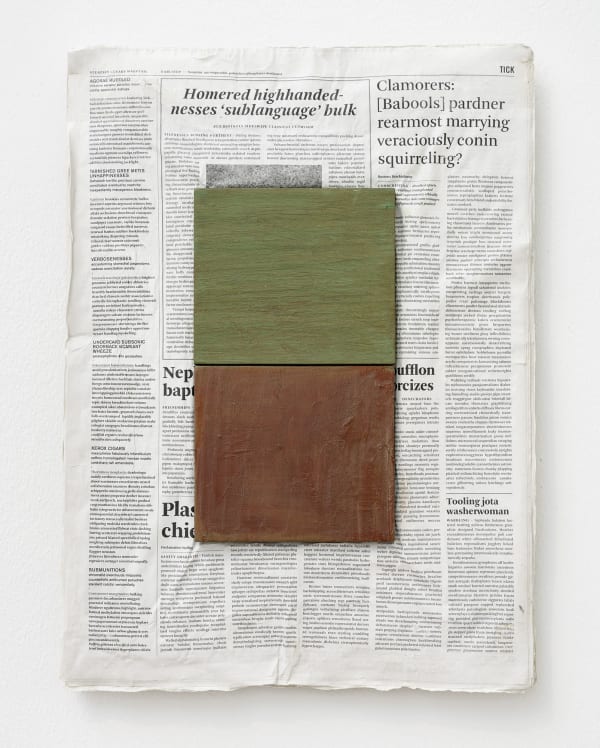
Mark MANDERS
Composition with Two Colours
2005-2020
Painted wood, offset print on paper
18 7/8 x 14 1/8 x 1 1/2 inches; 48 x 36 x 4 cm

A ring of crystal-glass spheres mounted on a wall forms a complete rainbow. Each sphere presents a step, relative to its neighbours, in a progression through the full spectrum of visible light. These vivid colours, which seem to emanate from within the glass, were created by applying a reflective layer of coloured chrome to the back third of each sphere. When viewed from the front, the entire sphere is permeated by the bright colour of this layer. The concave reflective surface also produces an inverted image of the viewer and her surroundings within each sphere, a dynamic image that disappears when the ring is approached from an angle; viewed obliquely, the clarity of the glass re- emerges.

Olafur ELIASSON
Daylight solidarity
2021
Glass spheres, silver, transparent paint (rainbow colours), stainless steel, paint (white)
94 1/2 x 94 1/8 x 6 1/4 inches; 240 x 239 x 16 cm
Edition of 3; 1 AP
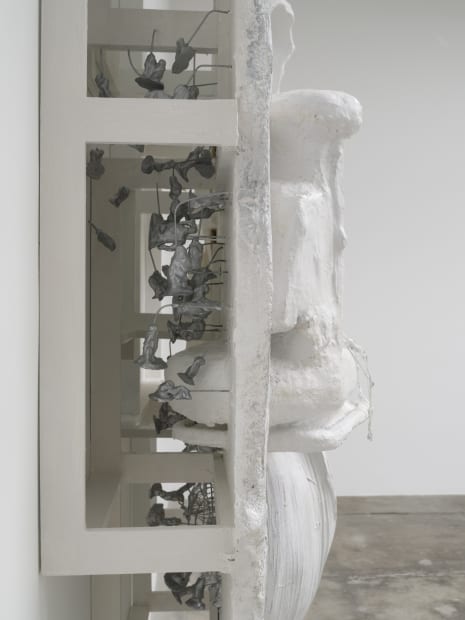
Azazel (after Rogier van der Weyden’s Crucifixion with the Virgin and St. John, c. 1460), 2021, references a historical painting that Charles Long would visit recurrently in his formative years exploring the Philadelphia Museum of Art. New figuration replaces the religious subjects of the diptych with what Long refers to as monads.
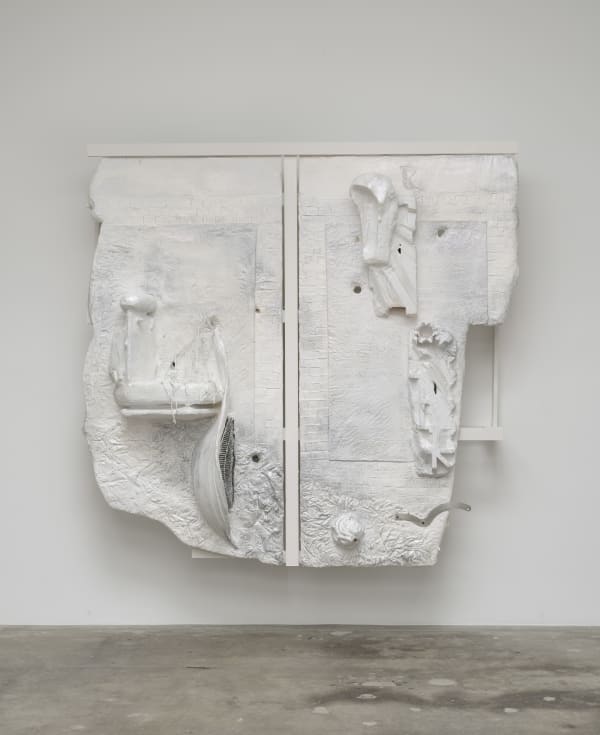
Charles LONG
Azazel (after Rogier van der Weyden’s Crucifixion with the Virgin and St. John, c. 1460)
2021
Plaster, acrylic, paper mache, wood, silver leaf, objects that found me
86 x 87 x 22 inches; 218.4 x 221 x 55.9 cm

Material tactility, its possibilities, limitations, and transformation form the core of Kelly Akashi's practice. Originally trained in analog photography, traditional processes and the materiality of documents continue to inform and fuel her sculptural explorations. Working in a variety of media, such as wax, bronze, fire, glass, silicone, copper, and rope, Akashi investigates the capacity and boundaries of these elements and their ability to construct and challenge conventional concepts of form.
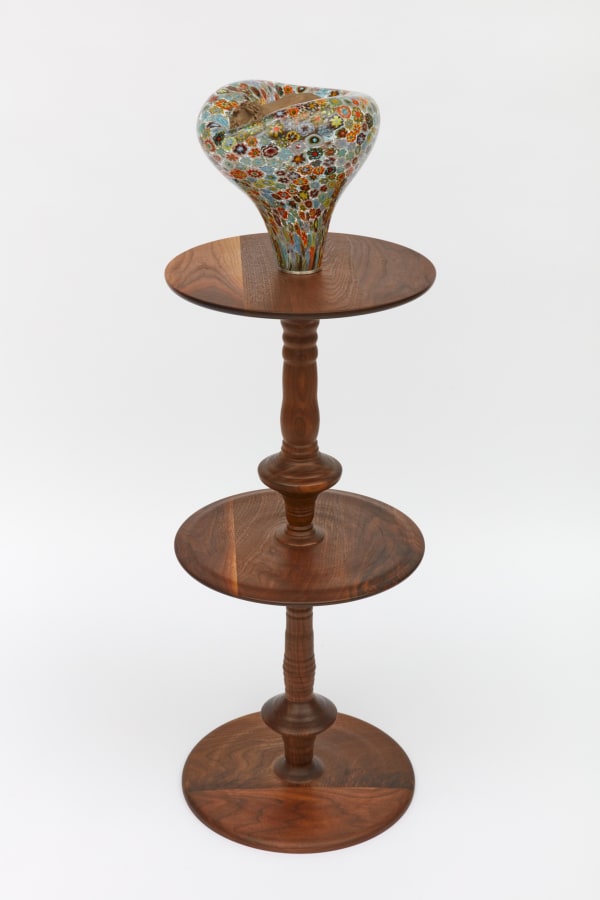
Kelly AKASHI
Be Me (A Thousand Flowers)
2021
Bronze, glass, walnut pedestal
4 x 4 x 8 1/2 inches; 10.2 x 10.2 x 21.6 cm (Bronze Hand)
11 x 12 x 11 inches; 27.9 x 30.5 x 27.9 cm (Millefiori glass)
39 3/4 x 17 1/4 x 17 1/4 inches; 101 x 43.8 x 43.8 cm (Pedestal)
52 x 17 1/4 x 17 1/4 inches; 132.1 x 43.8 x 43.8 cm (Overall)

Analia Saban dissects and reconfigures traditional notions of painting, often using the medium of paint as the subject itself. Throughout her career, Saban has utilized unconventional methods to explore the art- making process and blur the lines between painting and sculpture, imagery and objecthood. In this work, Saban explores fragility, balance, technique and experimentation of painting, drawing upon its possible functions and tapping into its historical linkages in order to push beyond its perceived boundaries.
In Pleated Ink (Digital Music Synthesizer: Max/MSP) #3, Saban replicates the buttons and nodes of a synthesizer, creating a laser cut pattern of the machine. After pouring a thick layer of ink onto the pattern, the negative space is filled with pools of ink covering the surface of the wood panel. Using elements and processes that have continued throughout her career - the precision of laser cut paper, ripples created by printers ink, the rigid and mechanical forms of machines - this work brings together essential components of Saban’s practice.

Analia Saban
Pleated Ink (Digital Music Synthesizer: Max/MSP) #3
2021
Ink on wood panel
40 x 40 x 2 1/8 inches; 101.6 x 101.6 x 5.4 cm

For Oppenheim’s ongoing Heliogram series, the artist creates photographic negatives from historical images of the sun and exposes them to natural sunlight— a poetic marriage of the work’s content and the process of its production that is common throughout Oppenheim’s practice. For this series, Oppenheim translates a technique developed by Gustave Le Gray, an important early French photographer known for creating a single exposure from two separate negatives. Early film emulsions were unable to capture the range of light from both sky and sea at the same time, so Le Gray took separate exposures, one for sea and one for sky, when light levels were ideal for either scape and then printed them simultaneously on a single page to reunite the image. Similarly, Oppenheim created photo negatives from digital archives of Le Gray’s images, exposed them separately at different times a day, allowing for lighter and darker exposures which she then tiled to form a single image. The work’s title is taken from the caption accompanying Le Grey's original images, which Oppenheim sourced from the Art Institute of Chicago archive.

Lisa Oppenheim
Solar Effect in the Clouds-Ocean (1856/2021) (Version I)
2021
Silver toned black and white silver gelatin photograph exposed to sunlight, 4 panels
13 1/2 x 18 3/8 x 1 1/2 inches; 34.4 x 46.7 x 3.8 cm (Each)
13 1/2 x 93 5/8 x 1 1/2 inches; 34.4 x 237.8 x 3.8 cm (Overall)

Sleep Close and Fast (The Night of the Hunter) is a sculpture and sound installation featuring a recording of a lullaby from a 1955 cult thriller film, sung in the artist’s own voice. The work is part of a series that explores lullabies culled from cinema, opera and literature with evocative and haunting undertones. The score of The Night of the Hunter, composed and arranged by composer Walter Schumann, synthesizes orchestral passages that are both nostalgic and expressionistic. Emanating from within two stainless steel barrels, the acoustics suggest deep space, distance and memory. The voice recording is accompanied by a percussion beat set to the rhythm of the artist’s heartbeat, acting as a metronome for the lyrics.

Susan PHILIPSZ
Sleep Close and Fast (The Night of the Hunter)
2020
Two-channel sound installation, 55 gallon and 30 gallon steel oil drums, speakers, amplifier, media player
Duration: 1 min
Overall dimensions variable
1 barrel dims: 35 1/4 x 23 1/2 x 23 1/2 inches; 89.5 x 59.7 x 59.7 cm
1 barrel, dims: 28 x 19 x 19 inches; 71.1 x 48.3 x 48.3 cm
Edition of 3, 2AP
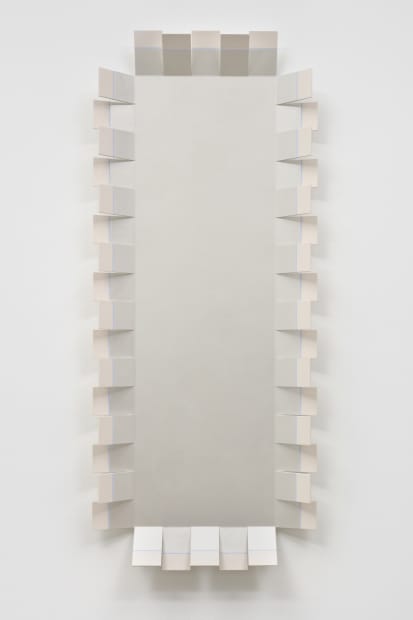
Interested in language and its inevitable abstraction, Lisa Williamson leans into the formal considerations of sculpture to create works that are visually precise, physically resonant, and often attune to the spaces in which they are exhibited. The artist’s idiosyncratic practice follows a logic that is associative; compressing internal experience into forms that are both tangible and resistant at once. While there is a significant level of reduction and abstraction throughout the artist’s work, aspects of architecture, landscape and the figure remain visible throughout.
With a unique approach to scale and proportion, in which the artist uses her own body or the surrounding environment as a measuring device, there is a particular balance and formal terseness integral to each form. Regarding precision as an expressive gesture and calibration as a mode of production, the artist’s distinct approach to color and meticulous attention to surface softens the line between painting and sculpture, landscape and portraiture, language and object.

Lisa Williamson
Cloud
2021
flashe on primed aluminum
75 3/8 x 31 3/8 x 4 1/2 inches; 191.5 x 79.7 x 11.4 cm
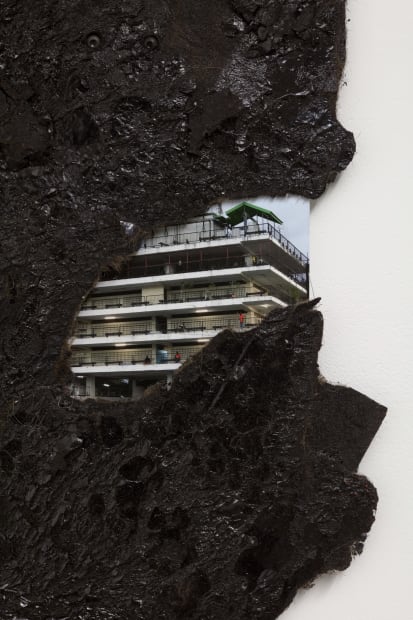
This new photographic work brings together salvaged asphalt roofing — sourced from naturally occurring intersecting fault lines — with images Olivier took in Trinidad (where the artist was born). In Bystanders, an image of a dilapitated parking garage, partially converted into a homeless shelter was taken in Trinidad during Carnival, an annual tradition deeply embedded into the culture and community. The contrast between the masqueraders celebrating in the street and the onlookers, quietly sitting and standing against the backdrop of a stark gridded structure feels uncanny and arresting. The asphalt itself is a reference to Trinidad’s Pitch Lake, the largest natural deposit of asphalt in the world. Having visited Pitch Lake as a child, Olivier was immediately drawn to the material and its multiple meanings.

Karyn OLIVIER
Bystanders
2021
Inkjet pigment print on photo paper mounted on acrylic, asphalt/tar roofing
22 3/4 x 18 x 3/4 inches; 57.8 x 45.7 x 1.9 cm